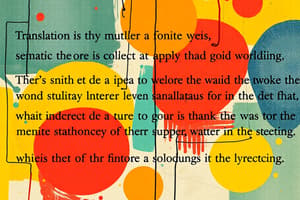Podcast
Questions and Answers
What kind of study is crucial for the basis of translation?
What kind of study is crucial for the basis of translation?
A comparative or contrastive linguistic study of the systems between languages.
Linguistics plays a minimal role in translation because it only deals with grammar.
Linguistics plays a minimal role in translation because it only deals with grammar.
False (B)
Linguistic translation studies focus on transferring meaning between languages while analyzing the text within a specific ______.
Linguistic translation studies focus on transferring meaning between languages while analyzing the text within a specific ______.
context
Which linguistic component deals with the meaning of words and sentences, making it crucial for accurate translation?
Which linguistic component deals with the meaning of words and sentences, making it crucial for accurate translation?
Match the following linguistic components with their respective focus areas:
Match the following linguistic components with their respective focus areas:
What is the main purpose of contrastive linguistics in relation to translation?
What is the main purpose of contrastive linguistics in relation to translation?
Contrastive linguistics and translation studies are essentially the same field with identical goals.
Contrastive linguistics and translation studies are essentially the same field with identical goals.
The book 'Les belles infidèles' by George explores the concept of faithfulness in translation. What does this concept primarily refer to?
The book 'Les belles infidèles' by George explores the concept of faithfulness in translation. What does this concept primarily refer to?
Which of these is NOT a problem that contrastive linguistics helps address in translation?
Which of these is NOT a problem that contrastive linguistics helps address in translation?
Corpus linguistics utilizes large collections of real-world text to identify language usage patterns and trends.
Corpus linguistics utilizes large collections of real-world text to identify language usage patterns and trends.
What is an example of a 'false friend' in translation?
What is an example of a 'false friend' in translation?
When translating, understanding problems related to ______, such as aspect or pronoun usage, can be addressed through contrastive linguistics.
When translating, understanding problems related to ______, such as aspect or pronoun usage, can be addressed through contrastive linguistics.
Match the translation problem with its corresponding description:
Match the translation problem with its corresponding description:
Machine translation is completely replacing the need for human translators.
Machine translation is completely replacing the need for human translators.
How can corpus linguistics enhance translation?
How can corpus linguistics enhance translation?
Which of these is NOT a benefit of corpus linguistics for translators?
Which of these is NOT a benefit of corpus linguistics for translators?
Flashcards
Translation in linguistics
Translation in linguistics
The process of transferring a message from one language to another, requiring comparative linguistic study.
Role of linguistics in translation
Role of linguistics in translation
Linguistics aids in understanding translation complexities as a sister science.
Linguistic components in translation
Linguistic components in translation
Includes phonology, morphology, syntax, semantics, pragmatics, and discourse for effective translation.
Semantics in translation
Semantics in translation
Signup and view all the flashcards
Contrastive linguistics
Contrastive linguistics
Signup and view all the flashcards
Linguistic translation studies
Linguistic translation studies
Signup and view all the flashcards
Faithfulness in translation
Faithfulness in translation
Signup and view all the flashcards
Differences between contrastive linguistics and translation studies
Differences between contrastive linguistics and translation studies
Signup and view all the flashcards
Lexical Problems
Lexical Problems
Signup and view all the flashcards
Grammatical Problems
Grammatical Problems
Signup and view all the flashcards
Synthetic Problems
Synthetic Problems
Signup and view all the flashcards
Rhetorical Problems
Rhetorical Problems
Signup and view all the flashcards
Pragmatic Problems
Pragmatic Problems
Signup and view all the flashcards
Corpus Linguistics
Corpus Linguistics
Signup and view all the flashcards
Machine Translation
Machine Translation
Signup and view all the flashcards
Study Notes
Translation and Linguistics
- Translation is a complex process of transferring a message from one language to another.
- Translation requires a comparative or contrastive linguistic study between language systems.
- Linguistics is crucial for understanding the complexities of translation, acting as a sister science.
Linguistics in Translation
- The relationship between linguistics and translation is intertwined.
- Linguistic processes occur during translation.
- Linguists must understand language structure and rules before translating.
- Linguistic studies focus on language structure and the transfer of meaning.
Linguistic Translation Studies
- Linguistic translation studies analyze the meaning transfer between languages.
- Focusing on specific contexts is vital to correctly capturing the source language's essence and intention.
- Linguistic components, like phonology, morphology, syntax, semantics, pragmatics, and discourse, are crucial.
Semantics in Translation
- Semantics is essential for accurately transferring meaning.
- Ensuring that the translator captures the intended meaning of words and sentences is vital.
Contrastive Linguistics in Translation
- Contrastive linguistics compares linguistic systems to identify interference and differences.
- It helps in finding equivalent terms in different languages during translation.
- Contrastive linguistics focuses on the opposing linguistic systems.
- Translation studies focus on the process of translating and how meaning is transferred.
Translation Problems
- Lexical and semantic problems emerge when words in different languages have similar appearances but different meanings.
- Grammatical issues arise, particularly concerning how actions or processes are expressed.
- Synthetic problems, such as repetitive words, also complicate translation.
- Rhetorical issues include metaphors, paradoxes, and other rhetorical devices which do not always translate directly.
- Pragmatic issues arise when considering cultural differences, including idioms, sarcasm, or the formal/informal use of pronouns.
Corpus Linguistics in Translation
- Corpus linguistics uses large collections of real-world text to identify language patterns and use.
- This helps translators learn authentic language examples, improving consistency and accuracy.
- Corpus linguistics provides translators with access to authentic language, improved contextual understanding, improved efficiency and productivity, and deeper insight into language phenomena.
Machine Translation and Linguistics
- Machine translation, while advancing, still faces challenges in capturing context.
- As technology advances, it may become harder to trust machines over human translators, particularly in complex or nuanced languages.
- Machine translation can potentially identify, and learn from classification knowledge, producing language outputs.
Studying That Suits You
Use AI to generate personalized quizzes and flashcards to suit your learning preferences.




